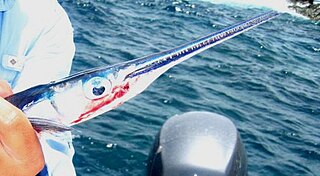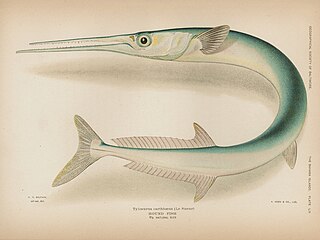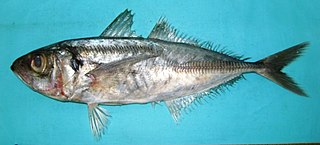
The shrimp scad, is a species of widespread tropical marine fish of the jack family, Carangidae. The shrimp scad is widely distributed in the tropical and subtropical western Indian Ocean and areas of the eastern Pacific Ocean, ranging from South Africa in the west to Hawaii in the east, including Japan and Australia to the north and south. The species is commonly found on inshore reefs and sandy substrates. It has the common body profile of a scad, and may be difficult to differentiate from others in the genus Alepes. It is one of the larger scads, growing to 40 cm, but often is encountered at much smaller sizes. The shrimp scad often forms large schools, and is carnivorous, consuming a variety of crustaceans and small fish. It is of moderate importance to fisheries throughout its range.

The horse-eye jack, also known as the big-eye jack, is a game fish and minor commercial fish in the family Carangidae. Its appearance is similar to that of the crevalle jack, although the horse-eye jack's head is not as blunt. The horse-eye jack is known to feed on smaller fish and on many invertebrates, such as shrimp and crab.

The longfin yellowtail, also known as the almaco or silvercoat jack, deep-water, falcate, European or highfin amberjack, rock salmon, longfin or yellow kingfish, is a game fish of the family Carangidae; they are in the same family as yellowtail and amberjack. They are carnivorous and feed, both day and night, on other, smaller fish, such as baitfish, small squid, octopus, crab and shrimp. The flesh is thick and dense, like tuna, and easily may be passed off for white albacore if prepared as sushi.

The cottonmouth jack is a gamefish in the family Carangidae. It was first described in 1860 by Cuban zoologist Felipe Poey in his two-volume work Historia Natural de la Isla de Cuba, or "Natural History of the Island of Cuba". It is also known as the cottonmouth trevally.

The lookdown is a species of game fish in the family Carangidae. It was first described in 1758 by Carl Linnaeus, in the 10th edition of Systema Naturae.
The keeltail needlefish, sometimes called the keeled needlefish, is a tropical fish of the family Belonidae. It was described by the French naturalist Charles Alexandre Lesueur in 1821.

The vadigo, Campogramma glaycos, is a species of medium-sized coastal marine fish in the jack family, Carangidae. The species is distributed throughout the eastern Atlantic Ocean from the British Isles in the north to Senegal in the south, also entering the western Mediterranean Sea. The vadigo is similar in form to both the leatherjacks and the queenfish, but can be distinguished by its scaleless chest and a broad, rounded upper jaw. It is a predatory fish, preying mostly on smaller schooling fishes. The species was initially classified under the genus Centronotus before being transferred to its own monotypic genus of Campogramma. The vadigo is of minor commercial importance throughout its range, and is also considered to be a game fish.

The mackerel scad, or speedo, is a species of fish of the family, Carangidae. While it can be considered gamefish, it is usually used as bait. It is popular for consumption in Hawai'i, the Philippines and the U.A.E. In Hawai'i, mackerel scad are called ʻopelu. In the Philippines they are called galunggong.

The round scad is a species of fish in the Carangidae. It was described in 1829 by the French naturalist and zoologist, Georges Cuvier. Although the round scad is considered a good food fish, it is mostly caught for use as bait.

The flat needlefish, or barred longtom, the only known member of the genus Ablennes, is a marine fish of the family Belonidae. Flat needlefish are considered gamefish, frequently caught with the help of artificial lights, but are not often eaten because of their green-colored flesh.

The houndfish is a game fish of the family Belonidae. It is the largest member of its family, growing up to 5 feet (1.5 m) in length and 10 pounds (4.5 kg) in weight. It is also often called the crocodile needlefish.

The longfin crevalle jack is a recently described species of large marine fish classified in the jack family, Carangidae. It inhabits the subtropical waters of the east Atlantic Ocean, ranging along the African coast from Mauritania south at least to Moçamedes in southern Angola, with the species historically present in the Mediterranean Sea. It is an inshore species, known to occasionally penetrate estuaries, possibly to spawn. The species is very similar to the crevalle jack, Caranx hippos, and is separated by its extended dorsal and anal fin lobes as well as more detailed anatomical features including dorsal and anal fin ray counts. The fish is known to reach 127 cm in length and 20.9 kg in weight. The longfin crevalle jack is a predatory fish, taking small fish as its main prey. Due to longstanding confusion between C. fischeri and C. hippos, the importance of each species to African fisheries is poorly understood, with a known combined catch in this region of between 2,233 and 10,054 tonnes per year in 1995–2004. Like its close relatives, the species is considered a powerful gamefish and highly sought after, although their coarse flesh makes for relatively poor quality food.

Chloroscombrus is a genus containing two species of tropical to temperate water marine fish in the jack and horse mackerel family Carangidae. Both members are commonly known as bumpers or bumperfish, with one species endemic to the Atlantic and the other to the eastern Pacific. They have a convex ventral profile compared to most other carangids, with small oblique mouths and low dorsal and anal fins. Phylogenetic studies have found they are most closely related to the jacks of the genus Hemicaranx, with these genera plus Selar, Selaroides and possibly Alepes, making up a clade within the Caranginae subfamily. They are predatory fish which live in both inshore and offshore environments ranging from estuaries to the edge of the continental shelf, and are of moderate importance to fisheries.

The Lebranche mullet or the liza is a species of saltwater fish in the family Mugilidae. It is found in the western Atlantic Ocean and Caribbean Sea and is fished commercially.

The smallspotted dart is an Indo-Pacific species of pompano in the family Carangidae.
The Pacific bumper is one of two game fish in the genus Chloroscombrus, from the subfamily Caranginae of the family Carangidae, part of the order Carangiformes.

Selene setapinnis, the Atlantic moonfish, is a West Atlantic fish belonging to the family Carangidae.

The lesser amberjack, also known as the false amberjack or little amberjack, is a species of ray-finned fish from the family Carangidae, the jacks and pompanos.
Trachurus delagoa, the African scad, is a species of jack mackerel from the family Carangidae which is found in the south western Indian Ocean.

The Arabian scad is a species of jack mackerel from the family Carangidae which is found in the Western Indian Ocean.




















